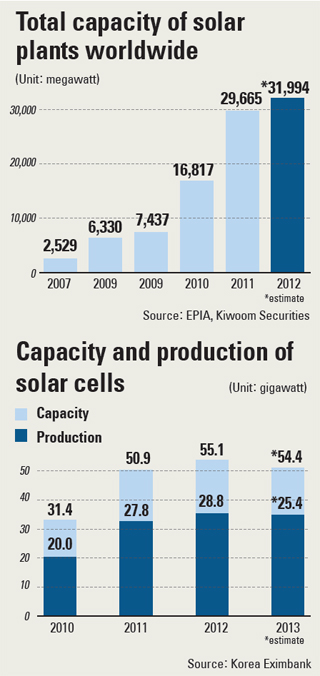Sun going down on local PV-panel makers’ prospects

Plant operations of local companies that produce solar panels dropped below 50 percent of their full capacity as of June, with five in every 10 factories idle last month, according to an industry source. Less than 80 percent of domestic companies in this sector now turn a profit, he added.
One local market researcher said the photovoltaic industry has grown less than 20 percent since late last year, compared to 50 percent in 2010.
As the recession in the industry continues for a second year, more small companies are going bankrupt.
“Eight solar cell companies went belly up last year, and several more are expected to shut down this year,” said an industry insider.
Globally, about 210 mergers and acquisitions took place in the industry last year as companies around the world also feel the pinch.
OCI, the world’s No. 2 polysilicon manufacturer, said in May it will stop making investments in two new plants as conditions in the photovoltaic market worsen in tandem with the growing fiscal crisis in the euro zone.
The company initially planned to invest more than 3 trillion won ($2.65 billion) in Gunsan, North Jeolla, to build the new plants, with an aim to expand production capacity of polysilicon, a core material for solar cells and modules, to 86,000 tons.
However, market conditions were hardly favorable as the price of the material has declined from $80 per kilogram ($36.3 per pound) in late 2010 to $24 as of last month.
According to Korea Eximbank, the total production capacity of solar cells worldwide now stands at 55.1 gigawatts, but global consumption is expected to reach just over half of this, or 28.5 gigawatts, this year. Market observers say total capacity of 40 gigawatts would be more than adequate.
The drawn-out recession in the domestic solar-panel industry stems largely from the euro crisis, as some 80 percent of local firms’ clients are based in Europe. Orders from the debt-stricken Continent fell sharply in the wake of the recent financial crisis.
Demand for solar energy plunged as the German and Italian governments slashed their subsidies for the industry. The two countries are the world’s largest consumers of solar energy.
Another obstacle for Korean companies comes in the form of their Chinese rivals, which offer cheaper prices based on lower production costs and bulk sales, triggering a supply glut and subsequent price drops.
As they are smaller in size and also dealing with a significantly lower demand at home, Korean companies have been dealt a bigger blow by the recession. Even by Asian standards, the domestic market is paltry. Annual demand for solar products stands at roughly 4 gigawatts in China and 1.6 gigawatts in Japan, while the corresponding figure in Korea is estimated at just 150 megawatts.
Industry officials see the current situation as continuing for two or three years. According to a recent report by consulting firm McKinsey, the global photovoltaic market is likely to recover in 2015 at the earliest.
“Supply and demand will start to stabilize in 2014, but few local firms will be able to hang on that long,” said Hong Jeong-mo, an analyst at Kiwoom Securities.
By Song Su-hyun [ssh@joongang.co.kr]










with the Korea JoongAng Daily
To write comments, please log in to one of the accounts.
Standards Board Policy (0/250자)